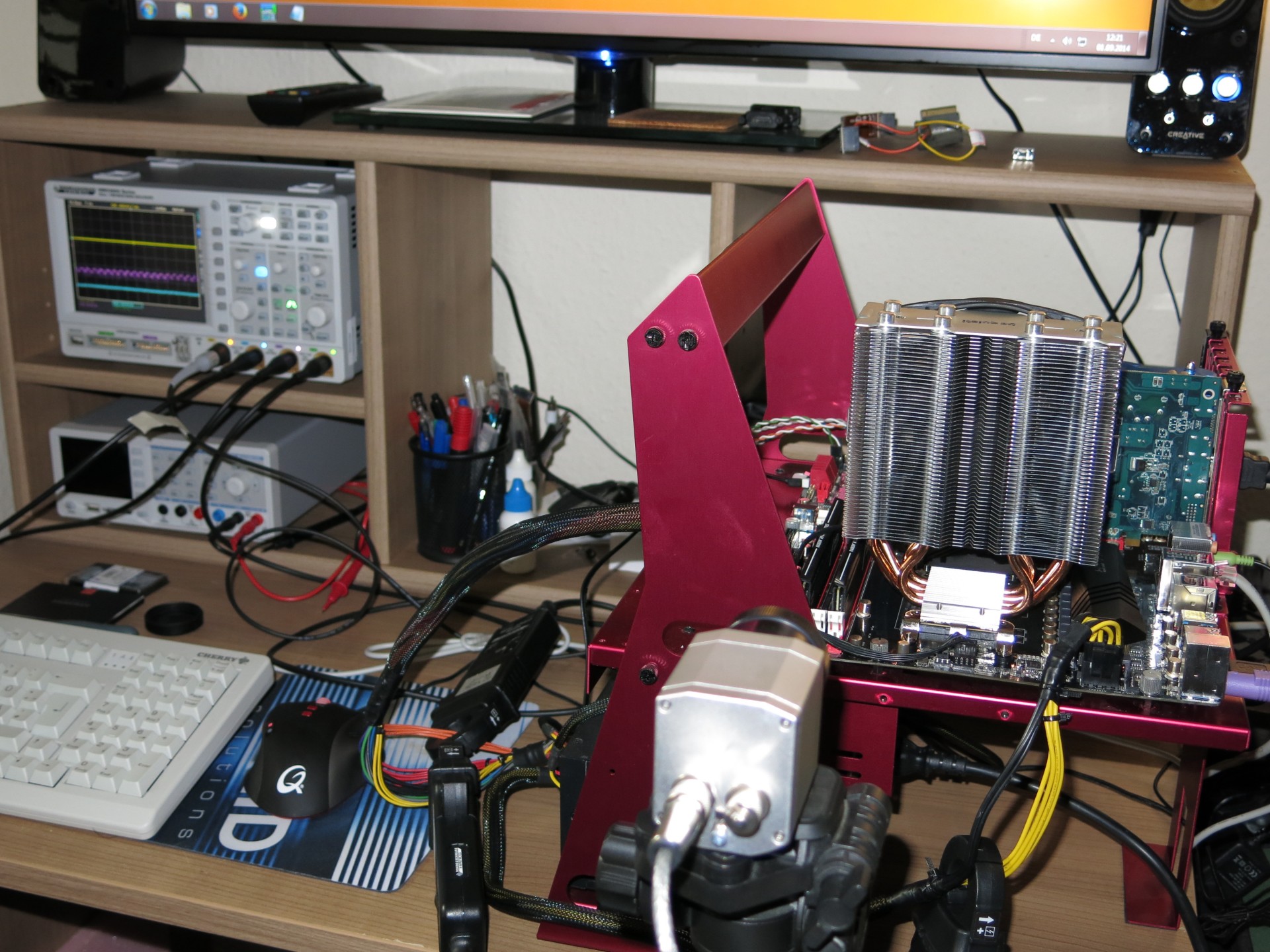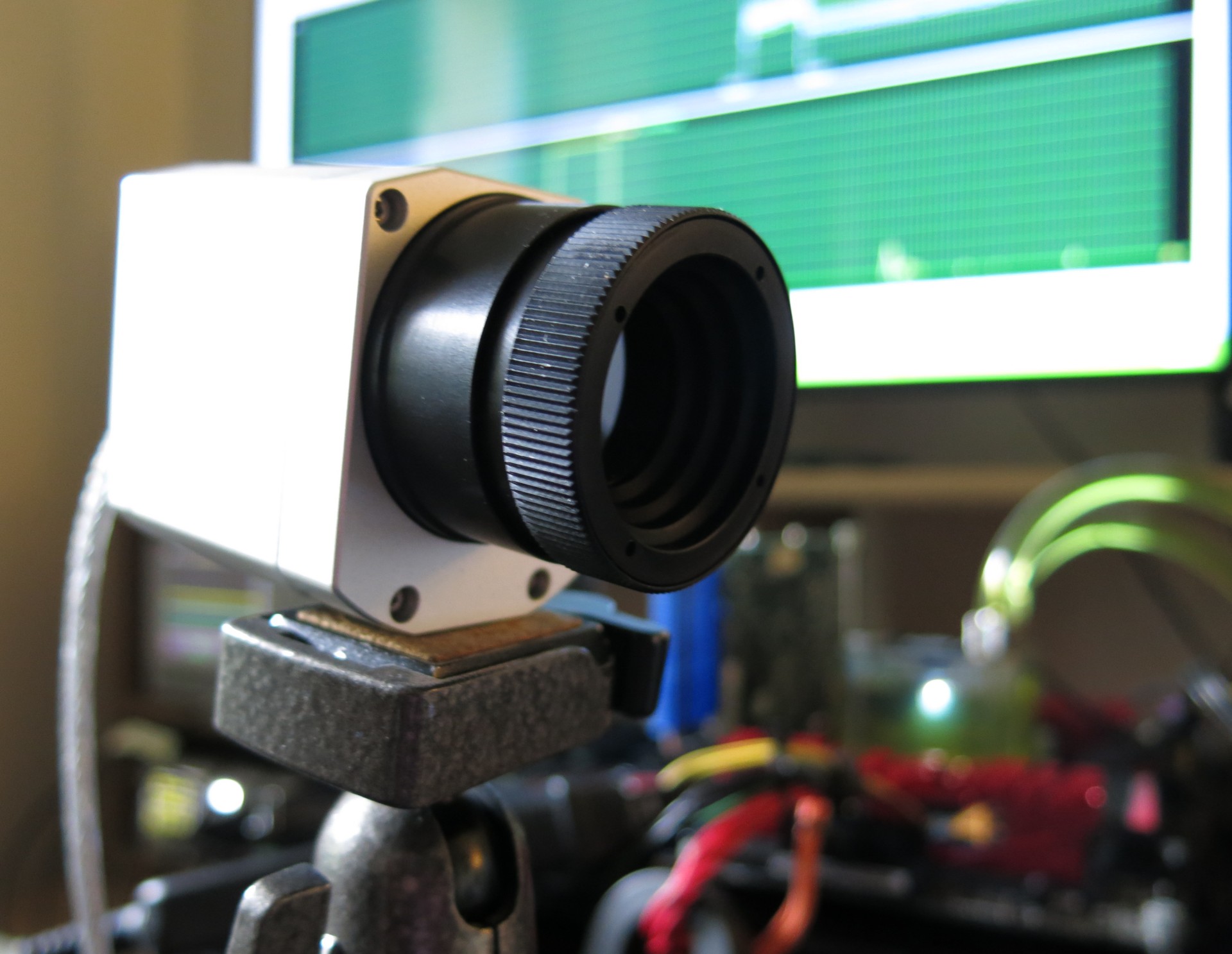AMD FX-8370E Review: Pulling The Handbrake For More Efficiency
Going more slowly is more efficient. That’s what AMD must have thought when they designed its new FX-8370E processor, thus closing a gap in the company's line-up. We evaluate whether this CPU is really more efficient and what happens when we overclock it.
Power Consumption At The FX-8370E's Stock Clock Rate
Test System And Measurement Methodology
Our German lab went the extra mile for drilling down into power consumption, cutting the braiding from our power supply's cables to give us the same measurement capabilities you've seen in our graphics card launch coverage. The readings are based on the four-channel HAMEG HMO 3054 oscilloscope.
We’ll first take a look at the power consumption, which we measured via the motherboard’s power connector and includes any losses due to the voltage regulators. Depending on load, these losses can reach eight percent. Because the ASRock motherboard AMD sent over doesn’t let us analyze the VR data, we weren’t able to factor out those losses, though. The FX-8370E’s actual power consumption is a bit lower than the values reported here.
| Test System | |
|---|---|
| System | AMD FX-8370Ebe quiet! Dark Rock Pro Air Coolerbe quiet! Shadow Rock Slim Air CoolerASRock Fatal1ty 990FX Killer16 GB Radeon DDR3-1866Samsung 850 EVO 512 GBbe quiet! Dark Power Pro 1200 WMicrocool Banchetto 101 |
| Methodology | No-contact current measurement at all railsVoltage measurementIR real-time monitoring |
| Equipment | 1 x HAMEG HMO3054, 500 MHz Four-Channel Oscilloscope4 x HAMEG HZO50 Current Probe4 x HAMEG HZ355 (10:1 Probe, 500 MHz)1 x HAMEG HMC8012 DSO1 x Optris PI450 80 Hz Infrared Camera + PI Connect |
Optris' PI450 is an infrared camera that was developed specifically for process monitoring. It supplies real-time thermal images at a rate of 80 Hz. The pictures are sent via USB to a separate system, where they can be recorded as video. The PI450’s thermal sensitivity is 40 mK, making it ideal for assessing small gradients.
We're also using be quiet! Dark Rock Pro. It’s a large dual-tower cooler with two fans that spin based on the CPU’s temperature. Even our highest overclock doesn’t pose a problem for it. As a result, the fans max out at 800 RPM, and our acoustic measurement equipment can’t pick it up. So, we're forgoing our usual noise level measurements.
Even after a lengthy test run, idle temperatures are extremely low. We start a new benchmark once the heat pipe cools down to 30 degrees Celsius.
Because we want to uncover the sweet spots for overclocking, voltage, and cooling, we’ll switch out the Dark Rock Pro CPU cooler for a less expensive model later, and then make our recommendation.
Here's another of the motherboard's shortcomings: a measurement of 75 degrees is way too high for a chipset at idle. We even measured well over 80 degrees Celsius on the chipset’s surface after running the motherboard inside of a case. That's enough to hurt your fingers, as I now know from experience.
Get Tom's Hardware's best news and in-depth reviews, straight to your inbox.
AMD FX-8370E at 3.3 GHz
Core Voltage
The core voltage, provided by the VRM, plays a prominent role in determining power consumption and how much waste heat is produced. A real 1.17 V reading is a bit lower than the BIOS setting of 1.1850 V. Interestingly, the value fluctuates a lot when the BIOS is set to regulate voltage automatically, whereas it doesn't if you switch the firmware to manual control.
The Turbo Core clock rate falls all the way to the base frequency during our stress test.
Power Consumption
At idle, we’re looking at 17 W. Under a taxing load, that number jumps to 75 W measured at the rail supplying the CPU. This is both unexpected and pleasant. It's the sort of power figure we've always wanted to see from a top-end AMD processor. After all, once the voltage regulator losses are calculated, we should be looking at right around 65 to 68 W. Sure, Intel's CPUs are lower still (and a great many faster, too), but not as far as you’d think.
Temperatures
A lower-power processor is bound to demonstrate better thermal performance. And indeed, the temperatures we're reporting are good at idle and under load. We could have probably used AMD's stock cooler without creating a bunch of annoying noise.
Heat pipes on the cooler we did use only warm up to 34 degrees Celsius. A 40-degree core temperature is also impressive.
Looking at the power consumption-to-performance ratio, we have a really interesting eight-core CPU that’s definitively better than what AMD offered previously in the FX family. Even though a lower clock rate results in a performance hit, the FX-8370E is exactly what we were hoping to see from AMD to begin with.
Current page: Power Consumption At The FX-8370E's Stock Clock Rate
Prev Page Introducing The AMD FX-8370E Next Page Power Consumption: Overclocking To 3.5 And 4.0 GHz
Igor Wallossek wrote a wide variety of hardware articles for Tom's Hardware, with a strong focus on technical analysis and in-depth reviews. His contributions have spanned a broad spectrum of PC components, including GPUs, CPUs, workstations, and PC builds. His insightful articles provide readers with detailed knowledge to make informed decisions in the ever-evolving tech landscape
-
MeteorsRaining The price point is a deal breaker. Its a fairly good CPU for AMD builders, but can't give it the tag of budget builder, you get i5 non-K in that price. Its moving into a higher (cost wise) territory with weak arsenal.Reply -
The_Doc How to start a benchmark review? But of course, let's show how powerful is AMD in single core!Reply
I think we all get it Vishera isn't exactly wonderful in single core operations, but:
A) I have yet to see any software which requires A LOT of single core power, it's 2014, if something is still single-core, it probably doesn't need all that power or il old enough to make even Vishera good at it.
B) You are comparing a 2012 architecture to a 4790K, It's like comparing Pentium 4 to a Pentium G3258.
-
husker Article quote: "However, it's probable that AMD sent us a sample chosen specifically for this purpose. Plus, there is almost certainly variance from one -8370E to the next. And so it's hard to know if the FX-8370E is actually better."Reply
If you pre-suppose that your sample is tainted why bother to do the testing and the article in the first place. Perhaps this is a case where your should purchase the product of the shelf in order to better serve your readers. -
1991ATServerTower I would have liked to see a power consumption chart of the following cpus all clocked to 3.8GHz.Reply
8150, 8320, 8230e, 8350, 8370e.
That would demonstrate the improvements of Vishera over Bulldozer, as well as any improvements offered by binning. -
oxxfatelostxxo "If you pre-suppose that your sample is tainted why bother to do the testing and the article in the first place. Perhaps this is a case where your should purchase the product of the shelf in order to better serve your readers."Reply
1) almost every vendor does this, cpus, graphics, ect..
2) the chip they received is exactly what you get when you buy it off the shelf, however every cpu/gpu ect varies by a small amount. The vendors simply make sure that review sites get the top end of that group. In all honesty we are probably talking 3% performance from the majority at most. -
ShadyHamster Any chance the older 8320/50 could be tested at the same voltages and clock speeds to better compare power usage?Reply
My 8320 will happily run 3.5/3.6ghz @ 1.15v as long as turbo core is disabled. -
m32 I've had a few 8350's that needed 1.41-1.45v for 4.5. These E models needs less voltage compared to the originals when dealing with "moderate" overclocks.Reply
I will probably get the 8320E for my office computer during Black Friday. $140 is the price right now but I prefer $125 or less for an AMD CPU. -
Chris Droste for all we know a nice, process-refined 8350 is the exact same chip under the hood, they just clocked it down and gave it a new name. someone wake me when AMD starts to innovate desktop CPUs again.Reply -
hmp_goose While it's nice to see a sweet spot staked out for the OC, and really nice to hear about how much smaller the heatsink can be, what I'd like to see if the E OCs cooler/ less wattage then the two non-Es. I like to think a 8350 is better then a 8320 if you care about power consumption at all, and want to see if the trend continues with the 8370 & 8370E …Reply -
RedJaron Reply
Precisely, which goes right along with what Igor said:14227111 said:The price point is a deal breaker. Its a fairly good CPU for AMD builders, but can't give it the tag of budget builder, you get i5 non-K in that price. Its moving into a higher (cost wise) territory with weak arsenal.
Yes 4.5 GHz and higher is possible, but at a certain point you're going to spend too much on a beefy motherboard and high-end cooler, negating the value of overclocking outright.
Far too many people forget the whole cost of OCing a chip. Sure, a 4.5 83XX can slightly beat a stock i5, but at what cost? The 6300 is a far more compelling CPU for tweakers. If you're lucky on a few sales, you can get the chip, cooler, and mboard for the same $200. And as pointed out here, unless you're pairing it with a top-shelf GPU, you won't see any gaming benefits with a pricier platform.
This is AMD's latest offering. The Haswell refresh is Intel's latest offering. Whatever the products' pedigrees, why shouldn't the two latest SKUs be compared?14227240 said:B) You are comparing a 2012 architecture to a 4790K, It's like comparing Pentium 4 to a Pentium G3258.








